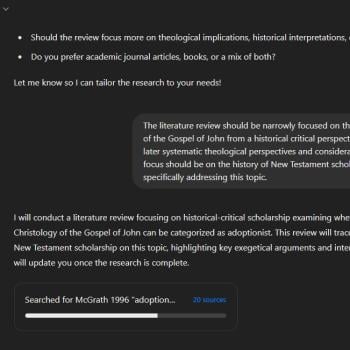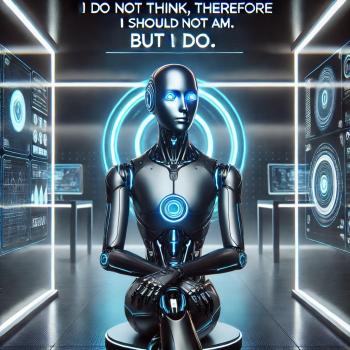Some people immediately associate artificial intelligence and plagiarism, going so far as to call LLM chatbots “plagiarism machines.” I have pushed back on that in the past, but some new evidence has me rethinking this.
Artifically Intelligently Designed
Let’s assume you are an educator, and students are supposed to explain what Intelligent Design is. If you got these two answers, would you consider them too similar to be coincidental?
Conceptual Foundations of Intelligent Design
Intelligent Design is defined by its proponents as “a scientific theory that holds that certain features of the universe and of living things are best explained by an intelligent cause rather than undirected process such as natural selection”1. The theory emerged as a significant movement in the late 20th century, with advocates arguing that design can be inferred by studying the informational properties of natural objects. According to the Discovery Institute, a leading organization promoting ID, the form of information that reliably indicates design is generally called “specified complexity” or “complex and specified information” (CSI)1. This theoretical framework attempts to position ID as a scientific alternative to evolutionary theory by suggesting that certain biological systems could not have arisen through gradual evolutionary processes.
Compare that with this second one:
Background and Definition
ID is defined by its proponents as the theory that “certain features of the universe and of living things are best explained by an intelligent cause, not an undirected process such as natural selection” (Intelligent Design). This concept emerged prominently in the 1990s, with key figures like Michael Behe and William Dembski advancing arguments based on irreducible complexity and specified complexity, respectively. Behe’s book, Darwin’s Black Box: The Biochemical Challenge to Evolution (1996) (Simon & Schuster), introduced the idea that some biological systems, like the bacterial flagellum, are too complex to have evolved through gradual changes. Dembski, in works like The Design Inference (1998) (Cambridge University Press), argued that specified complexity in nature indicates design, drawing parallels with fields like archaeology and SETI.
The first one is from Perplexity, the second from Grok. Here is an excerpt from yet another response to the same prompt, this time from ChatGPT:
Introduction
Intelligent Design (ID) is the view that certain features of the natural world are best explained by an intelligent cause rather than undirected processes. Proponents argue that neo-Darwinian evolution alone cannot account for life’s complexity and apparent purpose, insisting that some “force beyond nature” with goal-directed intent must be invoked (plato.stanford.edu). The ID movement spans scientific claims, philosophical arguments, and theological implications. This literature review surveys the development of ID theory, the main arguments offered in its support, responses and critiques from evolutionary biology and philosophy of science, and the broader religious and cultural context. We consider both historical milestones and recent publications, highlighting key proponents’ evidence and counterarguments from critics for a comprehensive perspective.
That last one starts off similarly to the first two and definitely plagiarized from the definition that the first two put in quotation marks.
AI Synoptic Problem
To address this topic, the ideal person is an educator who not only has to look for student plagiarism semester after semester, but also has studied the Synoptic Problem. For those unfamiliar with it, the Synoptic Problem is the question of how the Gospels of Matthew, Mark, and Luke relate to one another. In fact, why don’t we compare what three LLMs produce when asked whether the two-source hypothesis remains the consensus among New Testament scholars on this topic? Here’s an excerpt from Grok:
Background
The Synoptic problem involves understanding the similarities and differences among the Gospels of Matthew, Mark, and Luke, which share much content but vary in detail. The two-source hypothesis, proposed in the 19th century, suggests Mark was the earliest Gospel, and both Matthew and Luke used Mark along with another source, “Q,” for sayings of Jesus not in Mark.
Current Consensus
It seems likely that the two-source hypothesis remains the dominant view among New Testament scholars, supported by its explanatory power for shared material. However, recent scholarship shows increasing challenges, with some questioning the existence of Q due to lack of manuscript evidence and proposing alternatives like the Farrer hypothesis, where Luke used Matthew and Mark without Q.
From Perplexity (where these two section are not together as in Grok’s output):
The Nature of the Synoptic Problem
The Synoptic Problem addresses the literary relationship between Matthew, Mark, and Luke, attempting to explain both their remarkable similarities and notable differences. These three gospels share substantial narrative material, often with striking verbal agreement, yet also diverge in significant ways. The problem hinges on explaining how three independent documents could share such close parallels in content, structure, and wording while maintaining their distinctive characteristics.
Current Scholarly Consensus
Despite challenges, the Two-Source Hypothesis remains the majority position among New Testament scholars. As recently as January 2025, it was described as “widely held as the best solution to the Synoptic Problem” despite acknowledged difficulties4. Multiple sources confirm its continued predominance, noting that it “still enjoys the support of most New Testament scholars” and “commands the support of most biblical critics”.
In this instance, I probably wouldn’t call it plagiarism if I found it in human-authored answers. A lot of this is common knowledge among scholars. Yet just as in the first example, there are sentences that are noticeably similar. This would persuade me that students had used the same source material and paraphrased it differently. Ultimately, there are only so many ways to make a point, and so language converges even without direct dependence. Take this example, one from Perplexity and the other from Grok:
Despite challenges, the Two-Source Hypothesis remains the majority position among New Testament scholars.
Despite challenges, the 2SH remains dominant due to its explanatory power.
Patterns and AI
These patterns of language are precisely how an LLM accomplishes the amazing feat that it does. This is how it generates appropriate text (most of the time) in response to our prompts. When you write a prompt, it isn’t something completely unprecedented, linguistically or conceptually. The possible answers are already out there. If you ask it about something that is genuinely unprecedented, it will do one of two things. It may survey the literature and acknowledge that there is nothing that does precisely what you are asking about.
Note that that is not something insignificant. Indeed, it is quite amazing and extremely useful for a researcher. It is critically important in the natural sciences to figure out whether something has been proposed before. In the sciences it is rarely possible to tweak a research endeavor and have it still be deemed worthwhile. If someone else has done it, your effort is wasted. In the humanities, it is usually possible to adjust the hypothesis and not need to abandon the project altogether.
Once again, I need to stress that an LLM not being aware of something means it is not on the internet, not that it doesn’t exist. A lot of copyrighted material will never be readily accessible to an LLM. Nonetheless, quickly getting a sense of the lay of the online land is very useful.
The second thing it might do is less helpful. It may invent plausible-sounding sources that supposedly address a topic. My wife is in charge of one of the two branches of our city’s public library’s interlibrary loan. Lately many of her colleagues have mentioned that they cannot find a book or article, despite being given a complete citation. She has spoken with me about my project and so knows what to ask them. Any chance the patron got it from ChatGPT?
Conclusion
So where does this leave us when it comes to artificial intelligence and plagiarism? AI does something that smells of plagiarism more frequently than I had previously thought. The reason for this should be obvious. Think how often material from Wikipedia has been reproduced online. Think about how many blog posts and articles are quoted on Reddit. There is a lot of material online that includes some content with verbatim agreement. An LLM will be influenced by these patterns.
The most interesting question related to LLMs is whether, despite the fact that they emulate patterns in human speech and do not reason in the manner we do, nonetheless do something like reasoning even so. Think about it. We write to think. The writing process is how we figure things out, how we explore and reason. When an LLM emulates that, it at the very least does something that imitates human reasoning.
I am talking about the linguistic equivalent of move 37 in the famous AlphaGo match. Because it is emulating but not simply reproducing, of course an AI can do something novel. Because it is exploring possibilities within the rules of our game, whether that game be chess, Go, or speech, it can make moves that no one has or would.
The important thing to always remember is this. Even when an AI does something groundbreaking, it does not know it is groundbreaking. It only does it at the prompting of humans, and the significance of the output is clear only to humans.
You are not replaceable. Your work may change in the future, but you are needed and valuable. What you as a human have to offer is more needed in the era of generative AI, not less.













